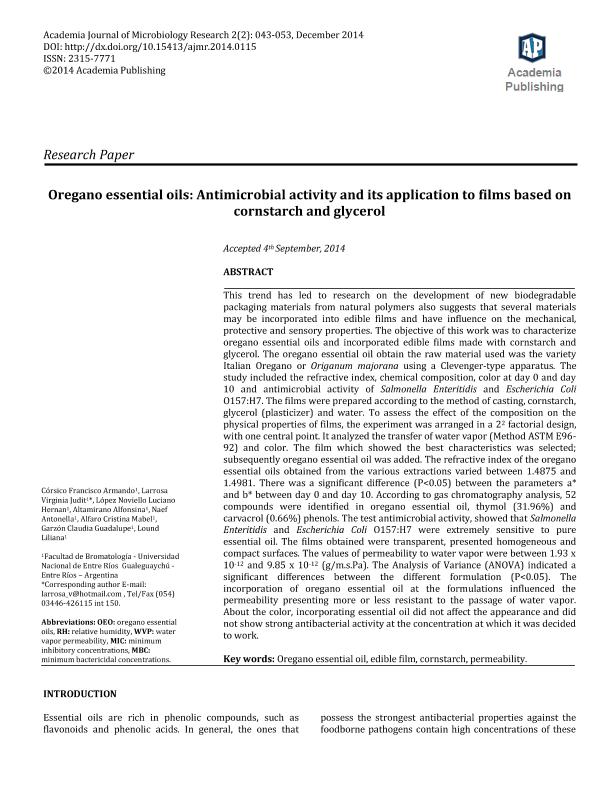Mostrar el registro sencillo del ítem
dc.contributor.author
Córsico, Francisco Armando

dc.contributor.author
Larrosa, Virginia Judit

dc.contributor.author
López Noviello, Luciano Hernán
dc.contributor.author
Altamirano, Alfonsina
dc.contributor.author
Naef, Antonella
dc.contributor.author
Alfaro, Cristina

dc.contributor.author
Garzón, Claudia Guadalupe
dc.contributor.author
Lound, Liliana Haydee

dc.date.available
2018-03-01T20:10:16Z
dc.date.issued
2014-12
dc.identifier.citation
Córsico, Francisco Armando; Larrosa, Virginia Judit; López Noviello, Luciano Hernán; Altamirano, Alfonsina; Naef, Antonella; et al.; Oregano essential oils: Antimicrobial activity and its application to films based on cornstarch and glycerol; Academia Publishing; Academia Journal of Microbiology Research; 2; 2; 12-2014; 43-53
dc.identifier.issn
2315-7771
dc.identifier.uri
http://hdl.handle.net/11336/37618
dc.description.abstract
This trend has led to research on the development of new biodegradable packaging materials from natural polymers also suggests that several materials may be incorporated into edible films and have influence on the mechanical, protective and sensory properties. The objective of this work was to characterize oregano essential oils and incorporated edible films made with cornstarch and glycerol. The oregano essential oil obtain the raw material used was the variety Italian Oregano or Origanum majorana using a Clevenger-type apparatus. The study included the refractive index, chemical composition, color at day 0 and day 10 and antimicrobial activity of Salmonella Enteritidis and Escherichia Coli O157:H7. The films were prepared according to the method of casting, cornstarch, glycerol (plasticizer) and water. To assess the effect of the composition on the physical properties of films, the experiment was arranged in a 22 factorial design, with one central point. It analyzed the transfer of water vapor (Method ASTM E96-92) and color. The film which showed the best characteristics was selected; subsequently oregano essential oil was added. The refractive index of the oregano essential oils obtained from the various extractions varied between 1.4875 and 1.4981. There was a significant difference (P<0.05) between the parameters a* and b* between day 0 and day 10. According to gas chromatography analysis, 52 compounds were identified in oregano essential oil, thymol (31.96%) and carvacrol (0.66%) phenols. The test antimicrobial activity, showed that Salmonella Enteritidis and Escherichia Coli O157:H7 were extremely sensitive to pure essential oil. The films obtained were transparent, presented homogeneous and compact surfaces. The values of permeability to water vapor were between 1.93 x 10-12 and 9.85 x 10-12 (g/m.s.Pa). The Analysis of Variance (ANOVA) indicated a significant differences between the different formulation (P<0.05). The incorporation of oregano essential oil at the formulations influenced the permeability presenting more or less resistant to the passage of water vapor. About the color, incorporating essential oil did not affect the appearance and did not show strong antibacterial activity at the concentration at which it was decided to work.
dc.format
application/pdf
dc.language.iso
eng
dc.publisher
Academia Publishing
dc.rights
info:eu-repo/semantics/openAccess
dc.rights.uri
https://creativecommons.org/licenses/by/2.5/ar/
dc.subject
Oregano Essential Oils
dc.subject
Edible Film
dc.subject
Cornstarch
dc.subject
Permeabilit
dc.subject.classification
Recubrimientos y Películas

dc.subject.classification
Ingeniería de los Materiales

dc.subject.classification
INGENIERÍAS Y TECNOLOGÍAS

dc.title
Oregano essential oils: Antimicrobial activity and its application to films based on cornstarch and glycerol
dc.type
info:eu-repo/semantics/article
dc.type
info:ar-repo/semantics/artículo
dc.type
info:eu-repo/semantics/publishedVersion
dc.date.updated
2018-02-09T19:52:59Z
dc.journal.volume
2
dc.journal.number
2
dc.journal.pagination
43-53
dc.journal.pais
Estados Unidos

dc.journal.ciudad
Nueva York
dc.description.fil
Fil: Córsico, Francisco Armando. Universidad Nacional de Entre Ríos. Facultad de Bromatología; Argentina
dc.description.fil
Fil: Larrosa, Virginia Judit. Universidad Nacional de Entre Ríos. Facultad de Bromatología; Argentina. Consejo Nacional de Investigaciones Científicas y Técnicas; Argentina
dc.description.fil
Fil: López Noviello, Luciano Hernán. Universidad Nacional de Entre Ríos. Facultad de Bromatología; Argentina
dc.description.fil
Fil: Altamirano, Alfonsina. Universidad Nacional de Entre Ríos. Facultad de Bromatología; Argentina
dc.description.fil
Fil: Naef, Antonella. Universidad Nacional de Entre Ríos. Facultad de Bromatología; Argentina
dc.description.fil
Fil: Alfaro, Cristina. Universidad Nacional de Entre Ríos. Facultad de Bromatología; Argentina
dc.description.fil
Fil: Garzón, Claudia Guadalupe. Universidad Nacional de Entre Ríos. Facultad de Bromatología; Argentina
dc.description.fil
Fil: Lound, Liliana Haydee. Universidad Nacional de Entre Ríos. Facultad de Bromatología; Argentina
dc.journal.title
Academia Journal of Microbiology Research
dc.relation.alternativeid
info:eu-repo/semantics/altIdentifier/doi/http://dx.doi.org/10.15413/ajmr.2014.0115
dc.relation.alternativeid
info:eu-repo/semantics/altIdentifier/url/https://www.academiapublishing.org/journals/ajmr/abstract/2014/Dec/Armando%20et%20al.htm
Archivos asociados
